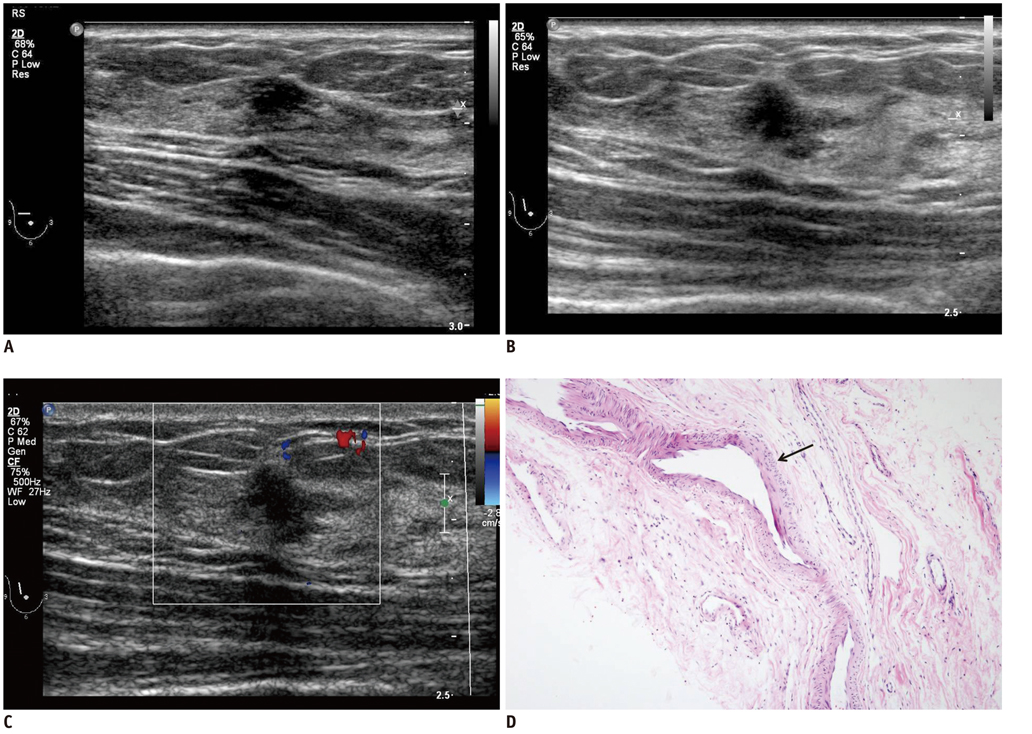Korean J Radiol.
2013 Oct;14(5):711-717. 10.3348/kjr.2013.14.5.711.
Band-Like Interposing Fat along Large Vessels: Ultrasonographic Pseudolesions of the Breast
- Affiliations
-
- 1Department of Radiology, St. Paul Hospital, The Catholic University of Korea College of Medicine Seoul 130-709, Korea. hskimsph@catholic.ac.kr
- 2Department of Radiology, Ewha Womans University School of Medicine, Seoul 158-710, Korea.
- 3Department of Radiology, Human Medical Imaging & Intervention Center, Seoul 137-902, Korea.
- 4Department of Pathology, St. Paul Hospital, The Catholic University of Korea College of Medicine Seoul 130-709, Korea.
- KMID: 1711423
- DOI: http://doi.org/10.3348/kjr.2013.14.5.711
Abstract
OBJECTIVE
The aim of this study is to evaluate the clinical characteristics and ultrasonographic findings of band-like interposing fat as well as to identify additional approaches for its diagnosis.
MATERIALS AND METHODS
This study included 26 confirmed cases of band-like interposing fat from June 2008 to June 2010. A retrospective analysis was performed to evaluate the clinical characteristics and ultrasonographic findings in these cases. Five radiologists analyzed the ultrasonographic findings, which correlated with the mammographic and MRI findings when available, according to Breast Imaging Reporting and Data System classification.
RESULTS
None of the 26 patients had any symptoms. In 92.3% of the patients, the lesion was located in the upper outer quadrant of the breast. The mean distance of the lesion from the nipple was 2.4 +/- 0.7 cm (1.1-4.5). The mean depth of the lesion from the skin was 1.3 +/- 0.3 cm (0.8-2.1). The mean maximal length of the lesion was 0.8 +/- 0.4 cm (0.3-1.8). The following were the most frequent ultrasonographic findings of lesions: irregular shape, not parallel orientation, indistinct margins, abrupt interface, hypoechogenicity, no posterior feature, no calcification, and presence of vascularity. The most frequent BI-RADS category was 4a. There were no suspicious findings on the mammography or MRI.
CONCLUSION
Ultrasonographic findings may lead to misclassification of band-like interposing fat as a malignancy. A better understanding of the clinical and ultrasonographic characteristics of band-like interposing fat would facilitate its differentiation from a true mass.
Keyword
MeSH Terms
Figure
Reference
-
1. Gordon PB, Goldenberg SL. Malignant breast masses detected only by ultrasound. A retrospective review. Cancer. 1995; 76:626–630.2. Kolb TM, Lichy J, Newhouse JH. Occult cancer in women with dense breasts: detection with screening US--diagnostic yield and tumor characteristics. Radiology. 1998; 207:191–199.3. Kopans DB, Feig SA, Sickles EA. Malignant breast masses detected only by ultrasound: a retrospective review. Cancer. 1996; 77:208–209.4. Sehgal CM, Weinstein SP, Arger PH, Conant EF. A review of breast ultrasound. J Mammary Gland Biol Neoplasia. 2006; 11:113–123.5. Spencer GM, Rubens DJ, Roach DJ. Hypoechoic fat: a sonographic pitfall. AJR Am J Roentgenol. 1995; 164:1277–1280.6. Landis JR, Koch GG. The measurement of observer agreement for categorical data. Biometrics. 1977; 33:159–174.7. Berg WA. Rationale for a trial of screening breast ultrasound: American College of Radiology Imaging Network (ACRIN) 6666. AJR Am J Roentgenol. 2003; 180:1225–1228.8. Stavros AT, Thickman D, Rapp CL, Dennis MA, Parker SH, Sisney GA. Solid breast nodules: use of sonography to distinguish between benign and malignant lesions. Radiology. 1995; 196:123–134.9. Kolb TM, Lichy J, Newhouse JH. Comparison of the performance of screening mammography, physical examination, and breast US and evaluation of factors that influence them: an analysis of 27,825 patient evaluations. Radiology. 2002; 225:165–175.10. Kerlikowske K, Grady D, Barclay J, Sickles EA, Ernster V. Effect of age, breast density, and family history on the sensitivity of first screening mammography. JAMA. 1996; 276:33–38.11. Cosgrove DO, Kedar RP, Bamber JC, al-Murrani B, Davey JB, Fisher C, et al. Breast diseases: color Doppler US in differential diagnosis. Radiology. 1993; 189:99–104.12. Raza S, Baum JK. Solid breast lesions: evaluation with power Doppler US. Radiology. 1997; 203:164–168.13. Baker JA, Soo MS, Rosen EL. Artifacts and pitfalls in sonographic imaging of the breast. AJR Am J Roentgenol. 2001; 176:1261–1266.14. Raza S, Goldkamp AL, Chikarmane SA, Birdwell RL. US of breast masses categorized as BI-RADS 3, 4, and 5: pictorial review of factors influencing clinical management. Radiographics. 2010; 30:1199–1213.15. Baker JA, Kornguth PJ, Soo MS, Walsh R, Mengoni P. Sonography of solid breast lesions: observer variability of lesion description and assessment. AJR Am J Roentgenol. 1999; 172:1621–1625.16. Lazarus E, Mainiero MB, Schepps B, Koelliker SL, Livingston LS. BI-RADS lexicon for US and mammography: interobserver variability and positive predictive value. Radiology. 2006; 239:385–391.17. Lee HJ, Kim EK, Kim MJ, Youk JH, Lee JY, Kang DR, et al. Observer variability of Breast Imaging Reporting and Data System (BI-RADS) for breast ultrasound. Eur J Radiol. 2008; 65:293–298.18. Cunningham L. The anatomy of the arteries and veins of the breast. J Surg Oncol. 1977; 9:71–85.19. Birdwell RL, Ikeda DM, Jeffrey SS, Jeffrey RB Jr. Preliminary experience with power Doppler imaging of solid breast masses. AJR Am J Roentgenol. 1997; 169:703–707.20. Wilkens TH, Burke BJ, Cancelada DA, Jatoi I. Evaluation of palpable breast masses with color Doppler sonography and gray scale imaging. J Ultrasound Med. 1998; 17:109–115.21. Pui MH, Movson IJ. Fatty tissue breast lesions. Clin Imaging. 2003; 27:150–155.
- Full Text Links
- Actions
-
Cited
- CITED
-
- Close
- Share
- Similar articles
-
- Ultrasonographic and Pathologic Findings of Dermatofibrosarcoma Protuberans of the Breast: A Case Report
- US Findings of Breast Sparganosis
- The analysis of ultrasonographic findings in breast carcinoma
- Ultrasonographic Findings of Breast Diseases During Pregnancy and Lactating Period
- Pseudolesions around the Gallbladder Fossa: Comparison of Frequency and Radiological Characteristics in Multiphasic CT, CTAP, and CTHA



